
At the end of last school year, I authored a blog for Michigan Arts Education Instruction and Assessment (MAEIA) titled To Grade or Not to Grade…That is the Question. At that time, I was exploring different assessment possibilities for my fifth and sixth grade art students. I have to grade. I have no choice. Since a new school year is now underway, I have decided to try a new form of assessment that is far more student-driven than teacher led. From my last blog, this particular section still resonates with me:
According to the MAEIA website, “Performance assessment asks students to apply their knowledge and skills to create a product, presentation, or demonstration focused on key aspects of standards. MAEIA assessments are aligned to standards that ask students to create, perform/present, and respond. In this way, assessment becomes part of the creative and learning process, rather than a separate experience.”
Enter the Portfolio
Having spent my undergraduate years carrying around a big brown paper portfolio filled with my paintings, sketches, and rough drafts, I understand the importance of showing work, over time, for feedback and improvement. So, this year, I am requiring my sixth grade students to create a digital portfolio using Canva’s free student presentation templates. Students fill their portfolio’s by engaging in digital assignments like: Portfolio Cover, Word Art, All About Me Collage, AI Photo Generator, Positive/Negative Skill Builder, Symmetrical Mansion, and an ‘I Am’ Mosaic. Each assignment has its own slide in the portfolio presentation. Additionally, to monitor the work over the semester, students submit each completed assignment to an online grading system (Canvas Learning Management System) for a complete or incomplete mark; by doing this, I have a record of how students are keeping up with their work. The Digital Portfolio project as a whole is what receives an actual rubric-based score.
 Creating digital portfolios allows students to have control over the design process, establishing a “look” or “personality” of their entire body of work. With very little direction from me, students were able to easily complete the task of designing the cover of their portfolio. Had I required students to draw and color a
Creating digital portfolios allows students to have control over the design process, establishing a “look” or “personality” of their entire body of work. With very little direction from me, students were able to easily complete the task of designing the cover of their portfolio. Had I required students to draw and color a 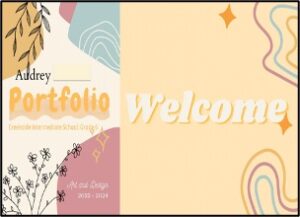 portfolio cover, much more time would have been needed. So, for me, using online templates saved time while still teaching basic the elements of a composition (font location, font size, font color, shapes, colors, balance, and unity). Once students created their portfolio cover, they set up the remaining pages using the design layout feature based on their chosen template design. Does it work? Take a look.
portfolio cover, much more time would have been needed. So, for me, using online templates saved time while still teaching basic the elements of a composition (font location, font size, font color, shapes, colors, balance, and unity). Once students created their portfolio cover, they set up the remaining pages using the design layout feature based on their chosen template design. Does it work? Take a look.
Presentation Templates
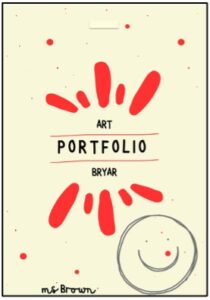
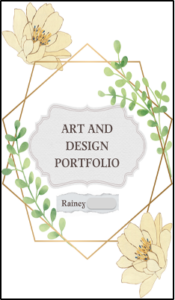
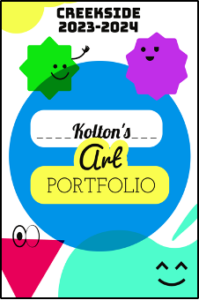
When putting this new assessment approach into practice, I took my own advice from my previous blog:
“As artists, we are all very familiar with creating a portfolio highlighting our best work. In the art room, at any grade level, what if we have students create digital portfolios (upper grades) or large folder portfolios (for younger students) that could be assessed as a complete body of work, instead of individual grades for each assignment? Stommel (as cited in Blum, 2020, p. 38) added, “The key is to use a portfolio not as a mere receptacle for assignments but as a metacognitive space, one with immediate practical value as a way for students to share their work.”
Student Writing and Reflection
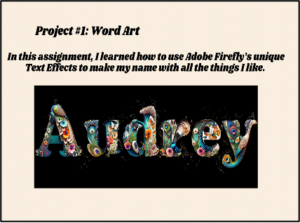 Many years ago, I was part of a Getty Education Grant in Southern California that required students to write reflective paragraphs about their art. While I believed the intention was good, many students struggled with how to explain what they made using descriptive language. Over the years since, I have moved away from having students write a lot about their work, but I still require titles on all projects submitted for grading. For this new portfolio assessment experiment, however, I am requiring students to write one clear reflective statement about their work, because I want them to learn to be concise with word choice. Additionally, when I tell students they only need to write one complete and concise sentence, they appear more open to the idea of writing. My goal is to increase what students write as the year progresses…but, for now, I am okay with just one sentence.
Many years ago, I was part of a Getty Education Grant in Southern California that required students to write reflective paragraphs about their art. While I believed the intention was good, many students struggled with how to explain what they made using descriptive language. Over the years since, I have moved away from having students write a lot about their work, but I still require titles on all projects submitted for grading. For this new portfolio assessment experiment, however, I am requiring students to write one clear reflective statement about their work, because I want them to learn to be concise with word choice. Additionally, when I tell students they only need to write one complete and concise sentence, they appear more open to the idea of writing. My goal is to increase what students write as the year progresses…but, for now, I am okay with just one sentence.
Entering a New Territory
I am curious to see if these portfolios are successful from an assessment point of view. Two days before the end of this rotation, students will submit their finished digital portfolios and I will review the contents with them during class. Grades for each rotation do not officially close until semester transitions; so, I am considering letting students continue to revise their work since they will return to art for a second rotation later in the year.
As art educators, I believe we have entered a new assessment territory based on technology and artificial intelligence. Our post-pandemic teaching practices have evolved, and so should our grading requirements. Assessing student art has always been difficult and has not fit the traditional grading scales. If, however, we focus on what students have learned individually through portfolio assessment, perhaps we can better identify what they have truly learned through this reflective process.
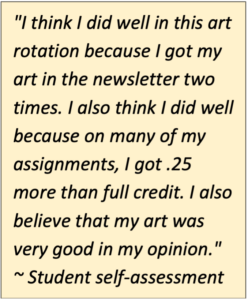
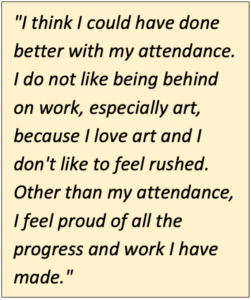

___________________________________________________________________________________________________________
 Jane Montero is a 5th/6th grade art teacher at Creekside Intermediate School in Dexter, MI. She has taught middle level art for 33 years and is a graduate of National Art Education Association’s School for Art Leaders in 2019. Jane earned her Doctor of Education in Leadership and Innovation in 2021. She currently serves as President-elect for the MAEA and is a team coach for MDE’s Formative Assessment in the Arts group. In 2023, Jane received the Outstanding Teaching award from NAEA’s Art Media Technology Interest Group and was Michigan’s Middle Level Art Educator of the Year and National Middle Level Art Educator of the Year, 2021-2022.
Jane Montero is a 5th/6th grade art teacher at Creekside Intermediate School in Dexter, MI. She has taught middle level art for 33 years and is a graduate of National Art Education Association’s School for Art Leaders in 2019. Jane earned her Doctor of Education in Leadership and Innovation in 2021. She currently serves as President-elect for the MAEA and is a team coach for MDE’s Formative Assessment in the Arts group. In 2023, Jane received the Outstanding Teaching award from NAEA’s Art Media Technology Interest Group and was Michigan’s Middle Level Art Educator of the Year and National Middle Level Art Educator of the Year, 2021-2022.
References
Blum, S. D. (2020). Ungrading: Why rating students undermines learning and what to do instead. West Virginia University Press.
Images provided by Creekside Intermediate School art students.
Click here for a Printer friendly version of this article.
Leave a Reply
You must be logged in to post a comment. Don't have an account? Register Here.